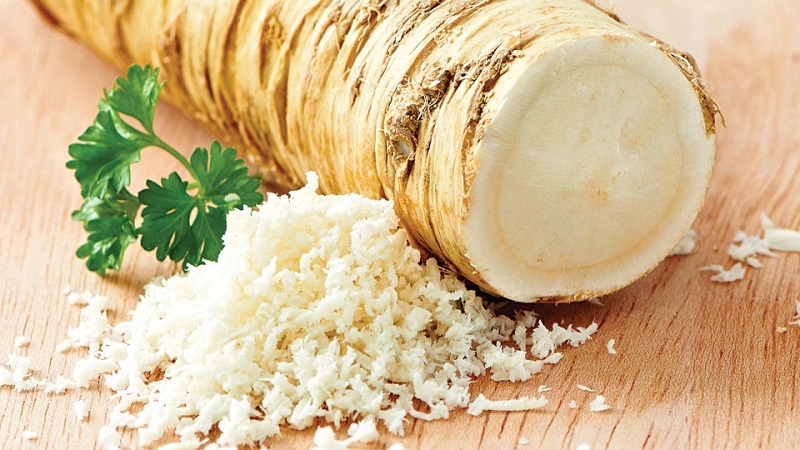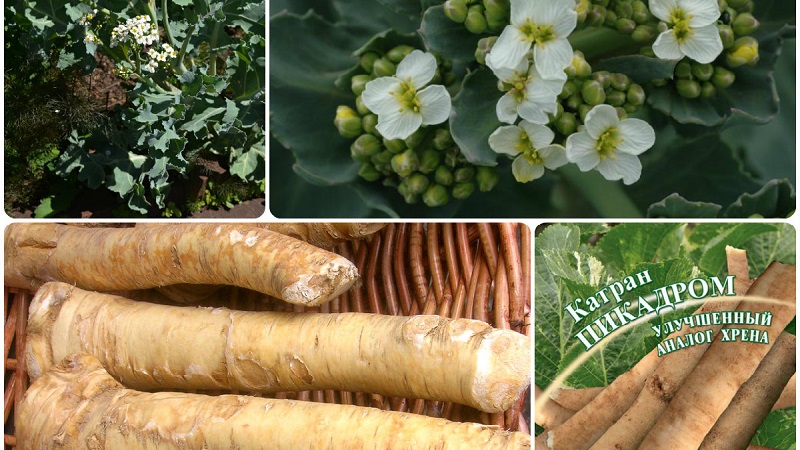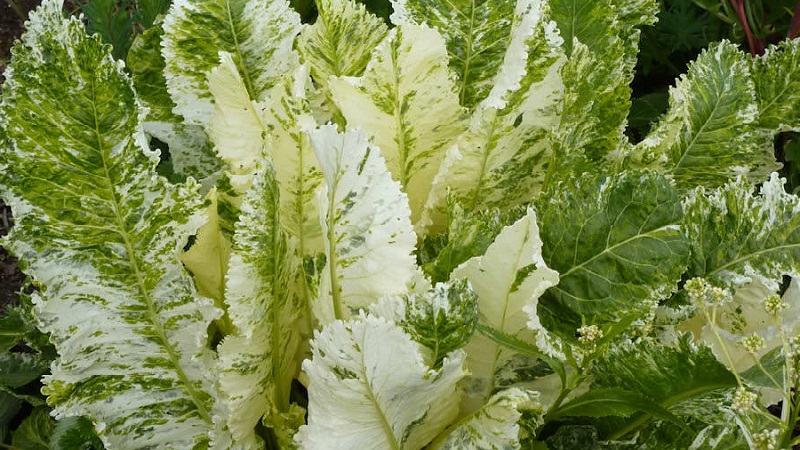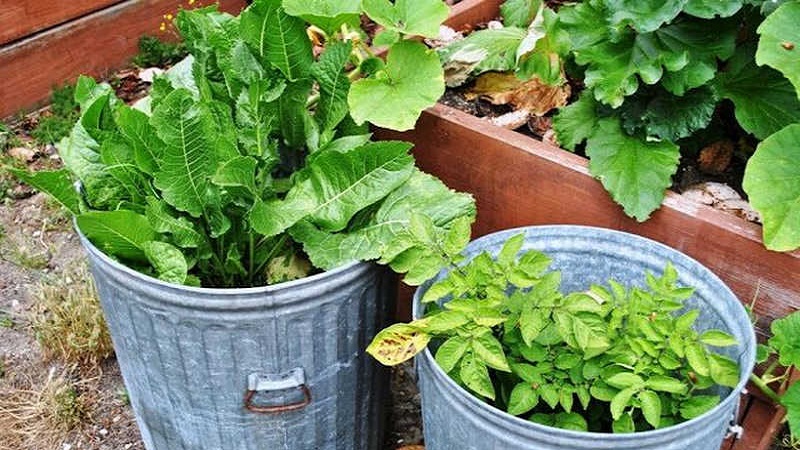What are the varieties of horseradish and how to choose the best
Horseradish as a spicy seasoning is loved not only in Russia, but also abroad. The roots and leaves of the plant are rich in essential oils, add spice to dishes and have antiseptic properties, therefore they are widely used in cooking and medicine. Thanks to its vitality and high adaptability, horseradish has become almost a weed - so quickly it grows and fills vegetable gardens. Nevertheless, the vegetable has several varieties and varieties, differing in characteristics, taste and requirements for agricultural technology.
The content of the article
What are the varieties and varieties of horseradish
A group of herbaceous plants, united by the collective name "horseradish", is part of the Cabbage family. There are 3 main types:
- Horseradish (Armorácia);
- Katran (Crambe);
- Eutrema.

The most common horseradish is ordinary, it is also horseradish village... It differs from other members of the family in a thick fleshy root, a tall, straight stem and lanceolate leaves. Widely distributed in Europe and western Asia.
Reference. In Russia, horseradish has been known since the 9th century as a spice and medicine. The etymology of the name goes back to the Old Frisian "roll" - "smell".
Katran gravitates towards the sea coasts - one of the plant species has the characteristic name Katran seaside. It differs from horseradish by a raised rosette of notched-lobed leaves. Due to its decorative appearance, it is often used in landscape design.
Eutreme grows in the arctic and alpine belt of Europe and North America... However, the most famous Japanese Eutrem, or Wasabi, is a creeping or ascending plant with heart-shaped leaves and a branched root.
Top best
An inexperienced summer resident will be surprised to learn what a variety of varieties and varieties the usual horseradish is represented. Let's talk about the best of them.
Katran
Katran has a low stem (50–70 cm) and a thick cylindrical root (up to 10 cm in diameter)... Unlike horseradish, it does not clog the area and has a milder taste.
Easily tolerates winter outdoors, especially in the presence of a thick snow cover, resistant to drought.

Among the varieties suitable for cultivation in Russia, there are:
- Accord - with white dense root pulp (weight - about 200 g);
- Picadrom - the root on the cut has a whitish-gray tint, reaches 900 g.
Wasabi
He is Eutrema Japanese, Japanese horseradish and green mustard... The most capricious variety to grow. The root grows extremely slowly - about 3 cm per year. Suitable for food from the second year.
Important! Seeds are sold only on order or on foreign websites (mainly Chinese trading platforms), so there is a high probability of getting low-quality material or an outright fake.
Atlant
Mid-season (growing season - up to 120 days) variety of horseradish, frost and drought resistant... The root grows up to 20 cm in length and 6 cm in diameter, has a curved shape, milky white when cut, the flesh is dense. The average weight is 380 g. The ground weight is dense, the leaves are dark green. Keeping quality is excellent.
Tolpukhovsky
Late-ripening variety (up to 200 days) of Russian selection... Suitable for mechanized cultivation. Productivity - about 1.2 kg / m².
Leaves are smooth, oblong-oval (70 × 20 cm).Horseradish forms a large cylindrical rough root weighing up to 400 g and 30–35 cm long, gray-white color, white flesh.
Valkovsky
In Russia, Moldova and Ukraine, the variety is called wild because of its wide distribution.... The culture is late ripening (up to 200 days of vegetation), resistant to flea beetles. Possesses a bright taste and a pronounced aroma.
The root with a yellowish skin and white flesh is shorter than that of other varieties - up to 15 cm. But by the end of the first year of vegetation it reaches 3 cm in diameter. Weight - 100–150 g. Productivity - 1.6 kg / m².
Latvian
The so-called ordinary, or garden, that is, non-selective horseradish... Distributed in the North-West of Europe, hence the name. Feels great in Central Russia.
Suzdal
Variety of Vladimir selection. According to vegetable growers, the most acute and "evil"... The culture is mid-season, the growing season is up to 120 days.
Deciduous mass is strong, roots are short and thick. They reach 15 cm in length and about 8 cm in diameter. The pulp is white, juicy and aromatic. Weight - up to 400 g.
Malinsky
A variety of Czech origin. The roots have a bright, sharp, but sweetish taste.... Productivity - 0.4 kg / m².
Reference.Before the collectivization of Czech lands in the middle of the 20th century, Malin horseradish was considered the best in Europe.
Variegata
From other varieties of rustic variegated horseradish Variegata has a marbled leaf color with transitions from light, almost white tones to dark green. The bush reaches a height of 1 m (peduncle - up to 1.5 m). Resistant to lodging, frost. Harvest in the second half of October.

How to choose
When choosing a variety, they ask themselves such questions:
- what taste of the product you want to get;
- what growing conditions are available.
Is there a softer vegetable? In this case, preference is given to Katran or the Malinsky variety. Fans of spicy horseradish will like Suzdal, Tolpukhovsky or Valkovsky varieties more.
Horseradish of Russian selection is unpretentious, so it's easy to grow it, but exotic Wasabi will require ingenuity and constant attention from the summer resident.
Reference.Horseradish often "spreads" over the area, displacing other vegetable crops. In order not to fight the "invader", horseradish is planted in a limited container (bucket or barrel) or Katran is chosen.
Depending on the region
Depending on the climatic features of the area, such plants are chosen:
- in southern regions with mild and warm climates - Katran, Tolpukhovsky (suitable for Central Russia);
- in the Central lane and the North-West region, the Latvian variety gives a rich harvest;
- The sharp contrast between winter frosts and summer heat in Siberia and the Far East will not frighten Atlant.
Artificial shelters are used to adjust the temperature and humidity. - hotbeds and greenhouses. This is especially true when growing wasabi.
Growing technology
Cuttings intended for planting are harvested in autumn at the same time as harvesting... As a rule, small branches cut off from the main rhizome are used for this. The size of the cuttings is about 25 cm in length and 0.5–1 cm in diameter (the more severe the climate of the area, the more powerful the cutting should be). The bottom of the plant is marked in the form of an oblique cut and placed in the ground at an angle of 30 °.
Horseradish loves fertile, loamy or sandy loam soil... The site should be moderately humid and lit (partial shade). The reaction of the soil is closer to acidic, around pH = 6. Favorable predecessors are cereals and legumes.
Important! Horseradish is able to live in one place for up to 10 years, so the site for it is chosen with great care.
Preparations containing potassium, nitrogen and sulfur are suitable for feeding.... Horseradish needs regular weeding and careful loosening of the soil. To combat fungal diseases (black rot and white rust), fungicides are used, and broad-spectrum insecticides help to remove insect pests (horseradish and canola leaf beetle, cabbage white beetle and horseradish flea).

In the ground
For planting horseradish raised (high) beds are made in open ground:
- In autumn, the soil is dug to a depth of about 40 cm, a complex of fertilizers is applied (5–9 kg of compost or rotted mullein, 25 g of urea, 50 g of superphosphate and 35 g of potassium chloride per 1 m² of land).
- In the spring, re-digging is carried out, a ridge of the earth is formed, which is strengthened with boards or other improvised means.
- Prepared cuttings are deepened into the ground, leaving a distance of 30 × 70 cm between plants. 2-4 cm of soil should rise above them.
In a container
So that horseradish does not grow over the site, it is planted in a bucket or barrel... For this:
- The container is filled with soil mixed with humus.
- They are buried in the ground, leaving the sides 2-3 cm high.
- Cuttings are planted in the prepared "flower bed".
Top dressing and watering with this growing method is performed as usual.... During harvesting, a bucket or barrel just needs to be pulled out of the ground and turned over on its side. Horseradish roots will not be damaged, they will be easy to reach.

Features of growing different varieties
Horseradish propagates mainly by cuttings... Seeds are also suitable for growing Katran, but large ones are chosen among them - they germinate faster. The optimal planting time is autumn or spring.
Agricultural technology for ordinary horseradish consists in timely watering and protection from insect pests... With sufficient fertility and light texture of the soil, the plant practically does not need serious feeding.
Reference. Some varieties (Atlant, Valkovsky) tolerate drought, frosts and infestations of a horseradish flea well.
The biggest challenge is growing Wasabi... This culture naturally grows along the banks of mountain rivers, therefore it loves humid air and regular irrigation with cool fresh water. At the same time, the plant does not tolerate stagnant water in the soil and sudden temperature changes (it should not go beyond + 7 ... + 23 ° C).
Collection, storage and processing of crops
The roots are harvested in the second half of October, not earlier than 2-3 years of growthso that horseradish has time to fill with essential oils. Young plants have a weak aroma, they are less useful. Root crops are dug up, cleaned of small roots and adhered clods of earth with a hard mitten.
Leaves are cut earlier, by the season for pickling cucumbers... At the same time, stems up to 10 cm long are left to protect the roots from damage.
Neither leaves nor roots are stored fresh for a long time, so it is important to correctly prepare:
- The cut green leaves are sorted out and placed in a plastic bag. It is important not to rinse or crush them in order to keep them longer. In the main compartment of the refrigerator, the vegetable does not lose its freshness for 10 days. As necessary, the workpiece is taken out and used for home preservation.
- They do the same with a freshly dug root: unwashed it is wrapped in plastic and stored in the refrigerator. Over time, the pulp becomes coarser and more fibrous, but the vegetable does not lose its flavor until spring.
- Immediately after harvesting, horseradish is processed into a spicy seasoning and rolled into jars. Such a preparation is edible for 6 months.
- A large amount of the crop is kept in the cellar. The roots are placed in wooden boxes, sprinkled with sand. To avoid drying out, the sand is slightly moistened, but then you have to make sure that mold does not start.
A sure way to conserve horseradish is to make a dry powder... For this, the root is washed, peeled, cut. Spread out in a thin layer, dry in the oven (1 hour at + 100 ° C and open door) or in an electric dryer. Store in linen bags or paper bags.
In Asian culture, dried wasabi is ground in a coffee grinder. The same method works for regular horseradish. To get a ready-to-use product, the powder is poured with hot water for 15 minutes.
Take a note:
Delicious sauerkraut with horseradish and carrots
Conclusion
For lovers of spicy seasonings, growing horseradish will bring a lot of pleasure at a minimum cost - it is only important to choose the right variety. It is better to plant a vegetable of Russian selection, as it is more adapted to climatic conditions and unpretentious. Katran and Malinsky variety will appeal to those who prefer a milder taste. Cultivating exotic Wasabi is not easy - sometimes it's easier to buy a finished product than to compete in ingenuity with a moody vegetable.